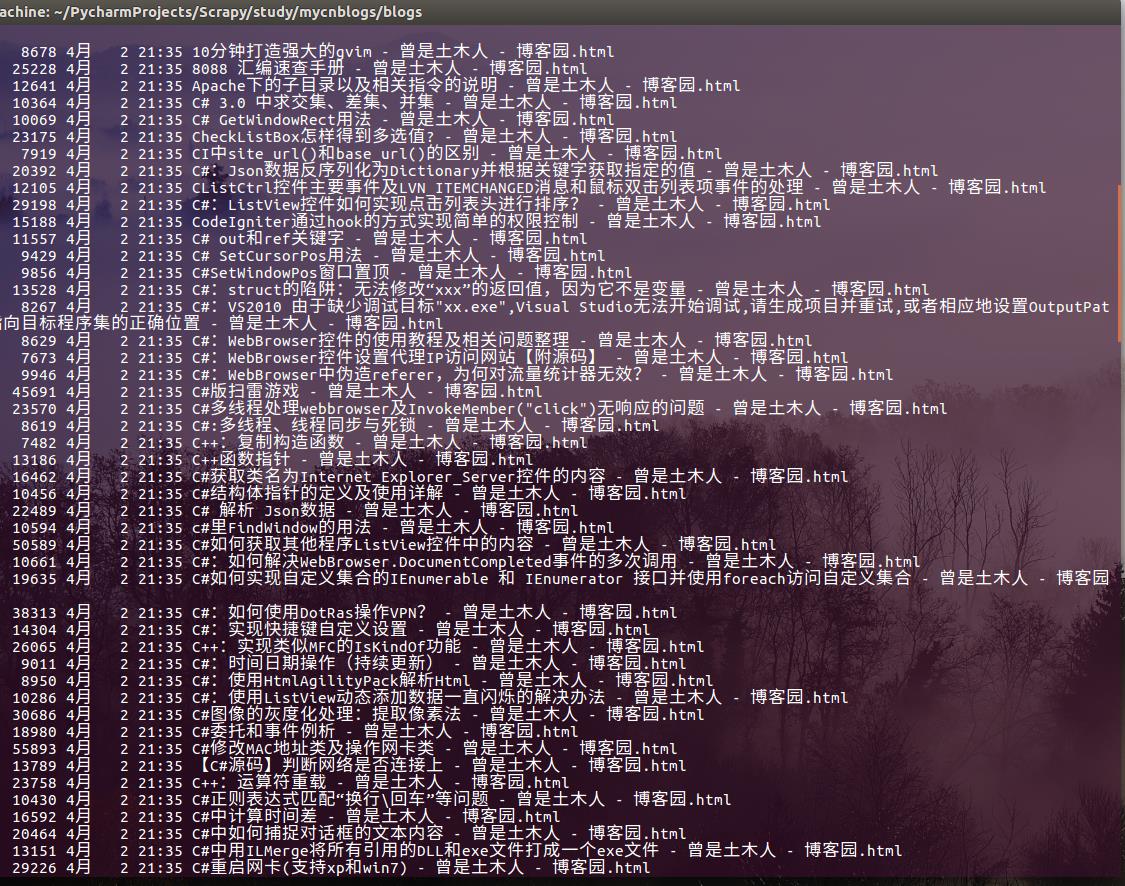实用scrapy批量下载自己的博客园文章
Posted 曾是土木人
tags:
篇首语:本文由小常识网(cha138.com)小编为大家整理,主要介绍了实用scrapy批量下载自己的博客园文章相关的知识,希望对你有一定的参考价值。
首先,在items.py中定义几个字段用来保存网页数据(网址,标题,网页源码)
如下所示:
import scrapy
class MycnblogsItem(scrapy.Item): # define the fields for your item here like: # name = scrapy.Field() page_title = scrapy.Field() page_url = scrapy.Field() page_html = scrapy.Field()
最重要的是我们的spider,我们这里的spider继承自CrawlSpider,方便我们定义正则来提示爬虫需要抓取哪些页面。
如:爬去下一页,爬去各个文章
在spdier中,我们使用parse_item方法来解析目标网页,从而得到文章的网址,标题和内容。
注:在parse_item方法中,我们在得到的html源码中,新增了base标签,这样打开下载后的html文件,不至于页面错乱,而是使用博客园的css样式
spdier源码如下:
# -*- coding: utf-8 -*- from mycnblogs.items import MycnblogsItem from scrapy.linkextractors import LinkExtractor from scrapy.spiders import CrawlSpider, Rule class CnblogsSpider(CrawlSpider): name = "cnblogs" allowed_domains = ["cnblogs.com"] start_urls = [\'http://www.cnblogs.com/hongfei/\'] rules = ( # 爬取下一页,没有callback,意味着follow为True Rule(LinkExtractor(allow=(\'default.html\\?page=\\d+\',))), # 爬取所有的文章,并使用parse_item方法进行解析,得到文章网址,文章标题,文章内容 Rule(LinkExtractor(allow=(\'hongfei/p/\',)), callback=\'parse_item\'), Rule(LinkExtractor(allow=(\'hongfei/articles/\',)), callback=\'parse_item\'), Rule(LinkExtractor(allow=(\'hongfei/archive/\\d+/\\d+/\\d+/\\d+.html\',)), callback=\'parse_item\'), ) def parse_item(self, response): item = MycnblogsItem() item[\'page_url\'] = response.url item[\'page_title\'] = response.xpath("//title/text()").extract_first() html = response.body.decode("utf-8") html = html.replace("<head>", "<head><base href=\'http://www.cnblogs.com/\'>") item[\'page_html\'] = html yield item
在pipelines.py文件中,我们使用process_item方法来处理返回的item
# -*- coding: utf-8 -*- # Define your item pipelines here # # Don\'t forget to add your pipeline to the ITEM_PIPELINES setting # See: http://doc.scrapy.org/en/latest/topics/item-pipeline.html import codecs class MycnblogsPipeline(object): def process_item(self, item, spider): file_name = \'./blogs/\' + item[\'page_title\'] + \'.html\' with codecs.open(filename=file_name, mode=\'wb\', encoding=\'utf-8\') as f: f.write(item[\'page_html\']) return item
以下是item pipeline的一些典型应用:
- 清理HTML数据
- 验证爬取的数据(检查item包含某些字段)
- 查重(并丢弃)
- 将爬取结果保存到数据库中
为了启用一个Item Pipeline组件,你必须将它的类添加到 ITEM_PIPELINES 配置,就像下面这个例子:
ITEM_PIPELINES = { \'mycnblogs.pipelines.MycnblogsPipeline\': 300, }
程序运行后,将采集所有的文章到本地,如下所示:

原文地址:http://www.cnblogs.com/hongfei/p/6659934.html
以上是关于实用scrapy批量下载自己的博客园文章的主要内容,如果未能解决你的问题,请参考以下文章